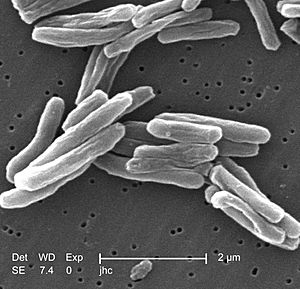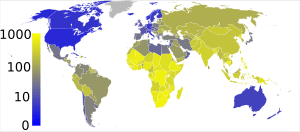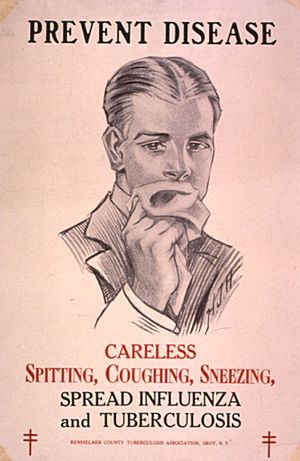Tuberculosis facts for kids
Tuberculosis (TB) is an infectious disease caused by bacteria. In the past, people called it consumption.
TB is caused by several types of mycobacteria, usually Mycobacterium tuberculosis. The disease usually attacks the lungs, but it can also affect other parts of the body.
Contents
Cause

The main cause of TB is Mycobacterium tuberculosis (MTB), a small, aerobic, nonmotile bacillus. The high lipid content of this pathogen accounts for many of its unique clinical characteristics.
It divides every 16 to 20 hours, which is an extremely slow rate compared with other bacteria, which usually divide in less than an hour. In nature, the bacterium can grow only within the cells of a host organism, but M. tuberculosis can be cultured in the laboratory.
How it spreads
The bacteria can travel through the air and spread from one person to the next. This happens when infected people cough, sneeze, or spit.
Of every 100 people with TB, between five and ten people show symptoms. In these people, the disease is called active. Tuberculosis kills more than half of the people who are infected if they do not get treatment.
Detection and treatment

Diagnosis of active TB relies on radiology. Doctors often look at an X-ray of the chest. In addition, they check body fluids. These fluids have microbes in them, which are grown in cell cultures. The cell cultures are then analysed to see if the person is infected with TB.
If the patient has TB but does not show symptoms, the disease is 'latent'. Doctors use a skin test, called the Mantoux test, to detect latent TB. They often do blood tests too.
There is a vaccine against some forms of tuberculosis. It is called bacillus Calmette–Guérin vaccine.
TB used to be easily treated and cured with antibiotics. However, the bacterium is now highly resistant to most antibiotics. This resistance makes treatment difficult. Many different kinds of antibiotics need to be given over a long period of time. There is a form of tuberculosis that is resistant to all drugs.
Symptoms
Tuberculosis can have many symptoms. The most common include:
- A cough that does not go away, especially if the person is coughing up blood (this is called hemoptysis)
- Chest pain
- Not having any appetite
- Weakness
- Weight loss
- Chills
- Very pale
- Listless eyes
- Fever
- Sweating a lot at night
- Difficulty breathing
- Feeling very tired
People are also more likely to get tuberculosis if they live close to other people who have TB. For example, TB can spread easily in homeless shelters, prisons, and immigrant communities.
How common is TB?

Experts believe that one third of the world population is infected with M. tuberculosis. New infections occur at a rate of one per second. In 2007, about 13.7 million chronic cases were active globally. In 2010, about 8.8 million new cases developed and nearly 1.5 million people died from the disease, most of them in developing countries. The number of tuberculosis cases has been decreasing since 2006, and new cases have decreased since 2002.
Tuberculosis does not happen at the same rate around the world. About eighty percent of the population in many Asian and African countries test positive for TB, but only five to ten percent of people in the United States do.
People usually get tuberculosis because of a weakened immune system. Many people with HIV and AIDS can also get tuberculosis.
Interesting facts about tuberculosis
- Tuberculosis was for centuries associated with poetic and artistic qualities among those infected, and was also known as "the romantic disease".
- Major artistic figures such as the poets John Keats, Percy Bysshe Shelley, and Edgar Allan Poe, the composer Frédéric Chopin, the playwright Anton Chekhov, the novelists Franz Kafka, Katherine Mansfield, Charlotte Brontë, Fyodor Dostoevsky, Thomas Mann, W. Somerset Maugham, George Orwell, and Robert Louis Stevenson, and the artists Alice Neel, Jean-Antoine Watteau, Elizabeth Siddal, Marie Bashkirtseff, Edvard Munch, Aubrey Beardsley and Amedeo Modigliani either had the disease or were surrounded by people who did.
- The only available vaccine as of 2021[update] is bacillus Calmette-Guérin (BCG).
- People with prolonged, frequent, or close contact with people with TB are at particularly high risk of becoming infected, with an estimated 22% infection rate.
- Tuberculosis is closely linked to both overcrowding and malnutrition, making it one of the principal diseases of poverty.
- Roughly one-quarter of the world's population has been infected with M. tuberculosis, with new infections occurring in about 1% of the population each year.
- Most infections with M. tuberculosis do not cause disease, and 90–95% of infections remain asymptomatic.
- Slow progress in preventing the disease may in part be due to stigma associated with TB.
- Tuberculosis incidence is seasonal, with peaks occurring every spring and summer. The reasons for this are unclear, but may be related to vitamin D deficiency during the winter.
See also
 In Spanish: Tuberculosis para niños
In Spanish: Tuberculosis para niños


